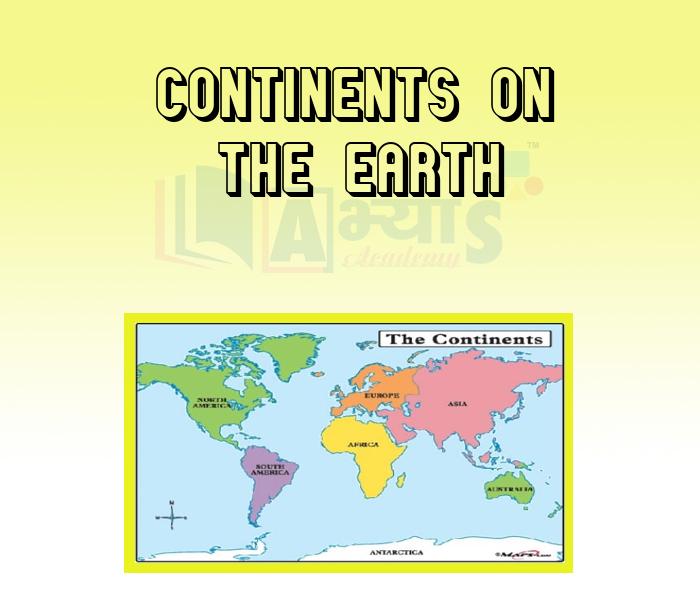Continents On The Earth

Continents On The Earth
Regional Geography:
Continents: There are seven continents on Earth.
Asia is the world's largest continent, both in terms of size and in terms of population. Covering approximately 30 percent of earth's area, the continent contains 44 nations and their dependencies. Asia boasts of the world's tallest peak 'Mt. Everest' at 8,848 metres, world's lowest point in 'Dead Sea at 392 metres below sea level, the world's deepest lake 'Lake Baykal' and the longest coastline among all continents.
Africa is the world's second largest continent and also the second most populous one. It is considered by many scientists to be the cradle of human civilisation in that the first humans are thought to have appeared here. Africa boasts of the world's longest river 'the Nile' and the world's largest desert 'Sahara 53 Desert'. Africa contains fifty-three countries and is surrounded by the Mediterranean Sea to the north, both the Suez Canal and the Red Sea along the Sinai Peninsula to the northeast, the Indian Ocean to the southeast, and the Atlantic Ocean to the west.
North America is our planet's third largest continent after Asia and Africa, and it includes twenty-three countries, and numerous possessions and territories. It contains USA, Canada, Mexico, all Caribbean and Central America countries, as well as Greenland the world's largest island. Located in our planet's 5 Northern and Western hemispheres, it is bordered in the north by the Arctic Ocean, in the east by the Pacific Ocean. Atlantic Ocean, in the southeast by the Caribbean Sea and Gulf of Mexico, and in the west by the Pacific Ocean.
South America is the earth's fourth largest continent after Asia, Africa and North America. It has twelve nations and three territories that are aligned to different nations including the Falkland Islands belonging .to UK, but a perennial bone of contention between UK and Argentina. Though a little lower than mid-way in the hierarchy of continent sizes, South America can lay claim to several largest natural formations, For instance, the Andes are the largest mountain range in the world while the Amazon is the world's largest river (in terms of size), with nearly 20 percent of Earth's fresh water. The Atacama Desert is the drient place on the earth while the Amazon rain forest is the largest rain forest on the earth.
Antarctica comprises approximately 9% of the earth's landmass and is composed of 98% ice. It is the only continent which is also a nation but has no capítal city. However, many nnations are laying a claim to the territory of Antarctica thanks to the perceived abundance of untapped mineral wealth of the uninhabited continent.
Europe is the earth's sixth largest continent and contains 47 nations and many dependencies. It is separated from Asia by Russia's Ural Mountains, and the Caspian and Black Seas. Danube, Volga, Thames and the Rhine are some of the major rivers of Europe. Europe's highest point, in European part of Russia, is Mt. Elbrus at 18,481 ft (5,633m). Its lowest point is on the edge of the Caspian Sea, at 92 ft (28m) below sea level.
Oceania, also called Australian Continent, is-the smallest of all the continents and contains jus over five percent of earth's total area. It contains fourteen nations and twenty-five dependeIcies
Students / Parents Reviews [10]
It was a good experience with Abhyas Academy. I even faced problems in starting but slowly and steadily overcomed. Especially reasoning classes helped me a lot.

Cheshta
10thOne of the best institutes to develope a child interest in studies.Provides SST and English knowledge also unlike other institutes. Teachers are co operative and friendly online tests andPPT develope practical knowledge also.

Aman Kumar Shrivastava
10thAbhyas Methodology is very good. It is based on according to student and each child manages accordingly to its properly. Methodology has improved the abilities of students to shine them in future.

Manish Kumar
10thAbout Abhyas metholodology the teachers are very nice and hardworking toward students.The Centre Head Mrs Anu Sethi is also a brilliant teacher.Abhyas has taught me how to overcome problems and has always taken my doubts and suppoeted me.

Shreya Shrivastava
8thI have spent a wonderful time in Abhyas academy. It has made my reasoning more apt, English more stronger and Maths an interesting subject for me. It has given me a habbit of self studying

Yatharthi Sharma
10thIt was good as the experience because as we had come here we had been improved in a such envirnment created here.Extra is taught which is beneficial for future.

Eshan Arora
8thIt has a great methodology. Students here can get analysis to their test quickly.We can learn easily through PPTs and the testing methods are good. We know that where we have to practice

Barkha Arora
10thBeing a parent, I saw my daughter improvement in her studies by seeing a good result in all day to day compititive exam TMO, NSO, IEO etc and as well as studies. I have got a fruitful result from my daughter.

Prisha Gupta
8thMy experience with Abhyas academy is very good. I did not think that my every subject coming here will be so strong. The main thing is that the online tests had made me learn here more things.

Hiya Gupta
8thA marvelous experience with Abhyas. I am glad to share that my ward has achieved more than enough at the Ambala ABHYAS centre. Years have passed on and more and more he has gained. May the centre flourish and develop day by day by the grace of God.










